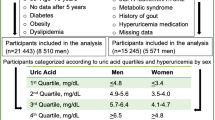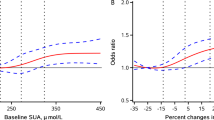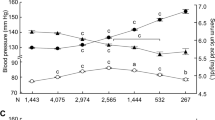Abstract
The prospective cohort study was to explore the association between serum uric acid (SUA) and arterial stiffness in a Chinese hypertensive population. A total of 7444 participants with hypertension who completed two or more measurements of brachial-ankle pulse wave velocity (baPWV) and baseline SUA detection were followed-up in the Kailuan Study from 2010 to 2020. A restricted cubic spline curve was used to verify whether there was a linear association between baseline SUA and arterial stiffness. A Cox proportional hazard regression model was used to explore the association of between baseline SUA and the incidence of arterial stiffness. Our results showed that the restricted cubic spline curve revealed a linear relationship between baseline SUA and arterial stiffness in total participants (p < 0.001). After follow-up 4.6 ± 2.8 years, Kaplan–Meier survival curves indicated that the risk of arterial stiffness was increased in the high level of baseline SUA (Log-rank p = 0.0002). After adjusting for potential confounding factors, the HR (95% CI) for risk of stiffness was 1.33 (1.17–1.52, p < 0.001) in the highest SUA group. Hierarchical analysis showed that the HRs (95% CI) for risk of arterial stiffness were 1.45 (1.25–1.69), 1.38 (1.19–1.60), 1.41 (1.21–1.64), and 1.35 (1.15–1.58) in the highest SUA group of males, <65 years old, not taking antihypertensive drugs, and failure to achieve the control targets of blood pressure respectively (p < 0.001). These results reveal that high SUA is a risk factor for arterial stiffness in the Chinese hypertensive population.

This is a preview of subscription content, access via your institution
Access options
Subscribe to this journal
Receive 12 print issues and online access
$259.00 per year
only $21.58 per issue
Buy this article
- Purchase on Springer Link
- Instant access to full article PDF
Prices may be subject to local taxes which are calculated during checkout



Similar content being viewed by others
References
Wang Q, Wen X, Kong J. Recent progress on uric acid detection: a review. Crit Rev Anal Chem. 2020;50:359–75.
Maiuolo J, Oppedisano F, Gratteri S, Muscoli C, Mollace V. Regulation of uric acid metabolism and excretion. Int J Cardiol. 2016;213:8–14.
Yanai H, Adachi H, Hakoshima M, Katsuyama H. Molecular biological and clinical understanding of the pathophysiology and treatments of hyperuricemia and its association with metabolic syndrome, cardiovascular diseases and chronic kidney disease. Int J Mol Sci. 2021;22:9221.
Wang Y, Zhang XY, Gao WH, Du MF, Chu C, Wang D, et al. Association of uric acid in serum and urine with arterial stiffness: Hanzhong adolescent hypertension study. Dis Markers. 2020;2020:1638515.
Albu A, Para I, Porojan M. Uric acid and arterial stiffness. Ther Clin Risk Manag. 2020;16:39–54.
Nagano S, Takahashi M, Miyai N, Oka M, Utsumi M, Shiba M, et al. Association of serum uric acid with subsequent arterial stiffness and renal function in normotensive subjects. Hypertens Res. 2017;40:620–4.
Jiang Y, Ge JY, Zhang YY, Wang FF, Ji Y, Li HY. The relationship between elevated serum uric acid and arterial stiffness in a healthy population. Vascular. 2020;28:494–501.
Kang HH, Won KB, Heo R, Han D, Chang HJ. Independent association of serum uric acid levels with arterial stiffness in the absence of established cardiovascular disorders. Int J Clin Pr. 2021;75:e13720.
De Feo M, Del Pinto R, Pagliacci S, Grassi D, Ferri C, Italian Society of Hypertension and Federfarma, et al. Real-world hypertension prevalence, awareness, treatment, and control in adult diabetic individuals: an Italian Nationwide Epidemiological Survey. High Blood Press Cardiovasc Prev. 2021;28:301–7.
Milan A, Zocaro G, Leone D, Tosello F, Buraioli I, Schiavone D, et al. Current assessment of pulse wave velocity: comprehensive review of validation studies. J Hypertens. 2019;37:1547–57.
An LN, Rong N, Ning M, Feng LL, Chen ZH, Liu WQ, et al. High serum uric acid is associated with increased arterial stiffness in hypertension. Aging. 2020;12:14569–81.
Wang C, Yuan Y, Zheng M, Pan A, Wang M, Zhao M, et al. Association of age of onset of hypertension with cardiovascular diseases and mortality. J Am Coll Cardiol. 2020;75:2921–30.
Zheng M, Zhang X, Chen S, Song Y, Zhao Q, Gao X, et al. Arterial stiffness preceding diabetes: a longitudinal study. Circ Res. 2020;127:1491–8.
Wu S, Xu L, Wu M, Chen S, Wang Y, Tian Y. Association between triglyceride-glucose index and risk of arterial stiffness: a cohort study. Cardiovasc Diabetol. 2021;20:146.
Song M, Li N, Yao Y, Wang K, Yang J, Cui Q, et al. Longitudinal association between serum uric acid levels and multiterritorial atherosclerosis. J Cell Mol Med. 2019;23:4970–9.
Han Y, Liu Y, Liu X, Yang W, Yu P, Wang J, et al. Association between cumulative serum urate and development of diabetes type II: the Kailuan study. Clin Rheumatol. 2020;39:339–46.
Wu S, Jin C, Li S, Zheng X, Zhang X, Cui L, et al. Aging, arterial stiffness, and blood pressure association in Chinese adults. Hypertension. 2019;73:893–9.
Wu Y, Liu Q, Ma Y, Han X, Zhao X, Zhao H, et al. Effect of parental arterial stiffness in offspring: the Kailuan study. J Hypertens. 2022;40:102–7.
Takashima N, Turin TC, Matsui K, Rumana N, Nakamura Y, Kadota A, et al. The relationship of brachial-ankle pulse wave velocity to future cardiovascular disease events in the general Japanese population: the Takashima study. J Hum Hypertens. 2014;28:323–7.
Levey AS, Stevens LA, Schmid CH, Zhang YL, Castro AF 3rd, Feldman HI, et al. A new equation to estimate glomerular filtration rate. Ann Intern Med. 2009;150:604–12.
Kerner W, Bruckel J. German diabetes A. Definition, classification and diagnosis of diabetes mellitus. Exp Clin Endocrinol Diabetes. 2014;122:384–6.
Civeira F, Arca M, Cenarro A, Hegele RA. A mechanism-based operational definition and classification of hypercholesterolemia. J Clin Lipido. 2022;16:813–21.
Yang AL, McNabb-Baltar J. Hypertriglyceridemia and acute pancreatitis. Pancreatology. 2020;20:795–800.
Miyoshi T, Ito H. Arterial stiffness in health and disease: the role of cardio-ankle vascular index. J Cardiol. 2021;78:493–501.
Munakata M. Brachial-ankle pulse wave velocity: background, method, and clinical evidence. Pulse. 2016;3:195–204.
Lee JG, Joo SJ. Arterial stiffness and cardiovascular risk. Korean J Intern Med. 2019;34:504–6.
Sanchez Bacaicoa C, Rico-Martin S, Morales E, Guimaraes Cunha P, Rodilla E, Lozano J, et al. Brachial-ankle pulse wave velocity with a custom device. Rev Clin Esp. 2021;221:145–50.
Rhee TM, Kim HL, Oh S, Lim WH, Seo JB, Chung WY, et al. Gender difference in the association between brachial-ankle pulse wave velocity and cardiovascular risk scores. Korean J Intern Med. 2019;34:539–48.
Tomiyama H, Yamashina A, Arai T, Hirose K, Koji Y, Chikamori T, et al. Influences of age and gender on results of noninvasive brachial-ankle pulse wave velocity measurement—a survey of 12517 subjects. Atherosclerosis. 2003;166:303–9.
Carlini NA, Harber MP, Fleenor BS. Age-related carotid extra-media thickening is associated with increased blood pressure and arterial stiffness. Clin Physiol Funct Imaging. 2021;41:461–6.
Jaruchart T, Suwanwela NC, Tanaka H, Suksom D. Arterial stiffness is associated with age-related differences in cerebrovascular conductance. Exp Gerontol. 2016;73:59–64.
Choi SY, Oh BH, Bae Park J, Choi DJ, Rhee MY, Park S. Age-associated increase in arterial stiffness measured according to the cardio-ankle vascular index without blood pressure changes in healthy adults. J Atheroscler Thromb. 2013;20:911–23.
Boutouyrie P, Chowienczyk P, Humphrey JD, Mitchell GF. Arterial stiffness and cardiovascular risk in hypertension. Circ Res. 2021;128:864–86.
Lage JGB, Bortolotto AL, Scanavacca MI, Bortolotto LA, Darrieux F. Arterial stiffness and atrial fibrillation: a review. Clinics. 2022;77:100014.
Chirinos JA, Segers P, Hughes T, Townsend R. Large-artery stiffness in health and disease: JACC state-of-the-art review. J Am Coll Cardiol. 2019;74:1237–63.
Voicehovska JG, Bormane E, Grigane A, Moisejevs G, Moreino E, Trumpika D, et al. Association of arterial stiffness with chronic kidney disease progression and mortality. Heart Lung Circ. 2021;30:1694–701.
Oikonomou E, Karlis D, Tsalamadris S, Siasos G, Chrysohoou C, Vogiatzi G, et al. Galectin-3 and arterial stiffness in patients with heart failure: a pilot study. Curr Vasc Pharm. 2019;17:396–400.
Singal AK, Karthikeyan G. Aspirin for primary prevention: is this the end of the road? Indian Heart J. 2019;71:113–7.
Titko T, Perekhoda L, Drapak I, Tsapko Y. Modern trends in diuretics development. Eur J Med Chem. 2020;208:112855.
Mingatto FE, Santos AC, Uyemura SA, Jordani MC, Curti C. In vitro interaction of nonsteroidal anti-inflammatory drugs on oxidative phosphorylation of rat kidney mitochondria: respiration and ATP synthesis. Arch Biochem Biophys. 1996;334:303–8.
Moreno-Sanchez R, Bravo C, Vasquez C, Ayala G, Silveira LH, Martinez-Lavin M. Inhibition and uncoupling of oxidative phosphorylation by nonsteroidal anti-inflammatory drugs: study in mitochondria, submitochondrial particles, cells, and whole heart. Biochem Pharm. 1999;57:743–52.
Pietri P, Vlachopoulos C, Terentes-Printzios D, Xaplanteris P, Aznaouridis K, Petrocheilou K, et al. Beneficial effects of low-dose aspirin on aortic stiffness in hypertensive patients. Vasc Med. 2014;19:452–7.
Okada Y, Shibata S, Fujimoto N, Best SA, Levine BD, Fu Q. Long-term effects of a renin inhibitor versus a thiazide diuretic on arterial stiffness and left ventricular diastolic function in elderly hypertensive patients. Am J Physiol Regul Integr Comp Physiol. 2017;313:R400–9.
Katsiki N, Dimitriadis GD, Mikhailidis DP. Serum uric acid and diabetes: from pathophysiology to cardiovascular disease. Curr Pharm Des. 2021;27:1941–51.
Ndrepepa G. Uric acid and cardiovascular disease. Clin Chim Acta. 2018;484:150–63.
Maloberti A, Giannattasio C, Bombelli M, Desideri G, Cicero AFG, Muiesan ML, et al. Hyperuricemia and risk of cardiovascular outcomes: the experience of the URRAH (Uric Acid Right for Heart Health) Project. High Blood Press Cardiovasc Prev. 2020;27:121–8.
Sugiura T, Dohi Y, Takagi Y, Yokochi T, Yoshikane N, Suzuki K, et al. Increased impact of serum uric acid on arterial stiffness and atherosclerosis in females. J Atheroscler Thromb. 2022;29:1672–91.
Hwang J, Hwang JH, Chung SM, Kwon MJ, Ahn JK. Association between serum uric acid and arterial stiffness in a low-risk, middle-aged, large Korean population: a cross-sectional study. Medicine. 2018;97:e12086.
Vlachopoulos C, Xaplanteris P, Vyssoulis G, Bratsas A, Baou K, Tzamou V, et al. Association of serum uric acid level with aortic stiffness and arterial wave reflections in newly diagnosed, never-treated hypertension. Am J Hypertens. 2011;24:33–9.
Rebora P, Andreano A, Triglione N, Piccinelli E, Palazzini M, Occhi L, et al. Association between uric acid and pulse wave velocity in hypertensive patients and in the general population: a systematic review and meta-analysis. Blood Press. 2020;29:220–31.
Cicero AF, Salvi P, D’Addato S, Rosticci M, Borghi C,Brisighella Heart Study Group. Association between serum uric acid, hypertension, vascular stiffness and subclinical atherosclerosis: data from the Brisighella Heart Study. J Hypertens. 2014;32:57–64.
Ramirez AJ, Christen AI, Sanchez RA. Serum uric acid elevation is associated to arterial stiffness in hypertensive patients with metabolic disturbances. Curr Hypertens Rev. 2018;14:154–60.
Bae JS, Shin DH, Park PS, Choi BY, Kim MK, Shin MH, et al. The impact of serum uric acid level on arterial stiffness and carotid atherosclerosis: the Korean Multi-Rural Communities Cohort study. Atherosclerosis. 2013;231:145–51.
Chen X, Li Y, Sheng CS, Huang QF, Zheng Y, Wang JG. Association of serum uric acid with aortic stiffness and pressure in a Chinese workplace setting. Am J Hypertens. 2010;23:387–92.
Wang H, Ba Y, Gao X, Zhuo J, Li Y, Sun J, et al. Association between serum uric acid to high density lipoprotein-cholesterol ratio and arterial stiffness in a Japanese population. Medicine. 2023;102:e34182.
Tian X, Chen S, Wang P, Xu Q, Zhang Y, Zhang X, et al. The impact of serum acid, arterial stiffness, and hypertension as a mediating factor: a cohort study. Hellenic J Cardiol. 2023. https://doi.org/10.1016/j.hjc.2023.07.009.
Acknowledgements
We thank the staff and participants of the Kailuan Study for their important contributions.
Funding
This study was supported by the National Key R&D Program of China (2020YFC2004703), National Natural Science Foundation of China (82070335 and 82370250), Research Project of the Shanghai Municipal Health Commission (202240036), and Project of Songjiang District Science and Technology in Shanghai (21SJKJGG48).
Author information
Authors and Affiliations
Contributions
LA: designing the project, statistical analysis, writing the original draft; LL and YW: statistical analysis, data cleansing; CM: statistical analysis; LX: data cleansing; GW: review and editing; DZ, SW and JH: resources, data curation, project administration, review and editing.
Corresponding authors
Ethics declarations
Conflict of interest
The authors declare no competing interests.
Additional information
Publisher’s note Springer Nature remains neutral with regard to jurisdictional claims in published maps and institutional affiliations.
Supplementary Information
Rights and permissions
Springer Nature or its licensor (e.g. a society or other partner) holds exclusive rights to this article under a publishing agreement with the author(s) or other rightsholder(s); author self-archiving of the accepted manuscript version of this article is solely governed by the terms of such publishing agreement and applicable law.
About this article
Cite this article
An, L., Wang, Y., Liu, L. et al. High serum uric acid is a risk factor for arterial stiffness in a Chinese hypertensive population: a cohort study. Hypertens Res (2024). https://doi.org/10.1038/s41440-024-01591-0
Received:
Revised:
Accepted:
Published:
DOI: https://doi.org/10.1038/s41440-024-01591-0
Keywords
This article is cited by
-
Is uric acid a causal risk factor of arterial stiffness in patients with hypertension?
Hypertension Research (2024)



